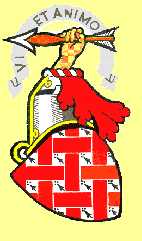![[Thin Blue Line]](../../../Photos/Line_Thin_Blue.gif)
 Coat of Arms of Clansfolk of Clan McCulloch
Coat of Arms of Clansfolk of Clan McCulloch
![[Thin Blue Line]](../../../Photos/Line_Thin_Blue.gif)
McCulloch House in Pictou was built by Thomas McCulloch, probably about 1808. The bricks used were of poor quality, carried from Scotland as ballast in ships. They have not stood the test of time well. Repairs will keep the house closed for the next two seasons.
The house is pure Scottish, with walls that are harled, or rendered over and finished with pebble dash or paint.
THE REV. DR. Thomas McCulloch arrived in Pictou in November 1803, on
his way to Prince Edward Island. Delayed by ice in the Strait, he was
recognized by Pictonians as worth keeping, was called to a church and
never reached P.E.I.
McCulloch settled, bought land, ran a school, which became Pictou
Academy in 1816, and finally built a house.
His students included some taking doctoral degrees in theology from
Glasgow University. John Audubon visited him to view his collection of
stuffed birds and declared it the best he had seen in North America.
McCulloch, minister, theologian, and educator, raised the standards of
education in the province.
McCulloch was appointed the first president of the new Dalhousie
College in 1838. He won the job despite a feud between non-conformists
and Anglicans, focused on King's College's exclusive rights to grant
theological degrees, thus eliminating Presbyterians from earning
degrees in Nova Scotia.
His house in Pictou has been altered, but most remains and is of great
interest. Like so many houses in the province it is of imported
design, pure lowland Scottish middle-class cottage, typical of houses
still to be seen in the town where McCulloch grew up. His choice of
style is understandable if one accepts the need of the immigrant to
build quickly based only on foreknowledge. What better than a usual
house?
Unfortunately, the house would have been cold. Solid brick provides
poor insulation and the open fires were inefficient, with typically 85
per cent of the heat passing straight up the flue.
As a home for a poor cleric-teacher, the house has a presence and
scale in its setting which is much more than the average Renfrewshire
kirk minister would have expected. Here is an internal finish in the
woodwork well above the average standard.
In his letters from Mephibosheth Stepsure, published originally in the
Acadian Recorder in 1822, we can still taste McCulloch's ascerbic wit,
his satirical comments on society, and his critiques of those in
charge, with parodies equal in their message as those of Jonathan
Swift. Here is a man transported out of his context, who nevertheless
carries on the practice of fine teaching and mind development,
irrespective of location.
His house is interesting for the interpreter. Built most probably in
1808, the house is pure Scottish, built with bricks from England.
These were of poor quality, rejected in England, and sold for ballast
to the colonies. The walls are of brick, but each opening is framed in
local stone, and so are the corners. This framing projects half an
inch in front of the brickwork.
If one compares the typical houses in the area from which he came in
Scotland, the walls are harled; that is, they are rendered over and
finished with pebble-dash, or paint.
The bricks have begun to crumble in recent years from the action of
moisture and frost, and so the house has to be repaired.
One feature that will be lost in repairs is evidence of the roof being
raised. The end walls clearly show where the roof was raised, in the
brickwork.
It appears that the roof was raised about 1907 when the house was
rented out as a summer cottage.
The inconvenience of few bedrooms was a deterrent so the mansard roof
was installed.
For the architectural conservationist, whose standard is "minimum
intervention," the issues raised by a crumbling house are important.
In this case, would the house have been better off if the rules of
conservation had been changed, so that the outer surface could have
been harled?
As the house has failed to pass the test of time in its walls, and the
water side has already been replaced, there is a possibility that the
common language of the architecture from Neilston, Scotland, might
have been more appropriate in an even more rugged climate.
That the bricks have failed to last is not surprising; rather we
should be surprised that they have lasted so long.
While we might debate what Thomas McCulloch might have done in the
same circumstances, there is always the problem of the stitch in time
saving nine.
The compromise between the historical veracity of the form and the
major change in unmaking a roof have to be balanced against the
ability to pay and the need for historic authority.
Given the dilemma of owning an unfinished house dating from 1808,
those in authority have made a decision to change as little as
possible, even though this turns out to be a large change. For those
of us interested in questions of historical integrity, building
conservation and interpretation, at the present time we can at least
record the present debate for the future, declaring our reasons.
The best part of the house is not its Scotch design, but the woodwork
and panelling it contains, and the museum visitor should consciously
absorb the stylistic connections to the Scottish origins.
From relatively humble beginnings, Thomas McCulloch rose to be a
founding university president. His house captures him in mid-flight,
reflecting the essential refinement of a man fit for high office,
complex, sensitive and very deep.
The Chronicle-Herald: Sunday, August 23, 1998
![[Thin Blue Line]](../../../Photos/Line_Thin_Blue.gif)
![[New Scotland (Nova Scotia) -=- Where the Heart is Still Highland!]](../../../Photos/Comb1_NS.gif)
![[Thin Blue Line]](../../../Photos/Line_Thin_Blue.gif)
 [Credits]
[Credits]
 Standard Disclaimer
Standard Disclaimer

 Copyright (C) 1996 * All Rights Reserved
Copyright (C) 1996 * All Rights Reserved

![[Long Marble Blue Line]](../../../Photos/blmarble.gif)